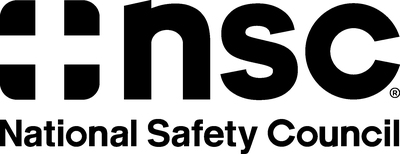Following initial 2020 research, Work to Zero
reexamines top workplace hazards and how adopting innovative
technology can mitigate risks
WASHINGTON, June 27,
2024 /PRNewswire/ -- In the
United States, a worker dies every 96 minutes with nearly
5,500 fatal work injuries occurring in 2022, according to the
Bureau of Labor Statistics. Unfortunately, this represents a nearly
6% increase in fatal occupational injuries from 2021 and a 3%
increase from pre-COVID-19 pandemic levels in 2019. To help reverse
this devastating trend, the National Safety Council launched
the Work to Zero initiative in 2019, with funding from
the McElhattan Foundation, to educate employers on technological
safety enhancements that can reduce deaths in the workplace.

In 2020, Work to Zero released its inaugural research
report identifying the most relevant workplace hazards and
technology to mitigate these risks, and conducted a survey of
employers and employees to understand their perceptions of safety
innovation in the workplace. In 2023, Work to Zero revisited its
initial findings to better understand the changes in safety
technology implementation over the previous three years. Today, NSC
is pleased to release its new report, Safety Technology
2024: Examining Trends in Technology Solutions Used to Reduce
Serious Injuries and Fatalities in the Workplace.
"At the heart of Work to Zero's mission is preventing worker
injuries and ultimately saving lives," said Katherine Mendoza, senior director of workplace
programs at NSC. "Since the initiative began, what we have found is
that there are numerous technology solutions available to employers
to help mitigate risks and keep workers safe. However, workplace
hazards are constantly evolving as job demands change, which is why
it's critical to regularly assess industry risks to better
understand trends and find the right solutions. This report does
precisely that with a focus on the impact of safety technology
implementation over a three-year period."
As a part of Work to Zero's initial 2020 research, employers and
employees in high-risk industries were surveyed with a goal to
understand the awareness, attitudes and usage of safety
technologies within different fields, as well as the top concerns,
most likely exposures and biggest contributors to injuries. The
survey was redeployed in 2023 to examine trends in workplace
hazards and safety technology implementation since 2020. Key
findings include:
- Increased exposure to risks: Both employers and
employees reported an increased likelihood of exposure to all
workplace risks included in the survey – such as fatigue, heavy
equipment operation and working at height – with the most
significant increases reported by employees.
- Fatigue remains the top risk across industries and the
largest contributor to injuries in the workplace. While workplace
violence is considered the least likely exposure, concern over
these incidents significantly increased from 2020 to 2023.
- Enhanced technology applicability and consideration:
Across all surveyed technologies, employers reported these
solutions to be relevant to the hazards in their workplaces.
Additionally, 83% of employees agreed they were open to trying and
using new safety technologies in the workplace.
- Technology use: The most notable increases in technology
usage were for risk management software, proximity sensors and
drones, while use of other technologies has remained relatively
similar between surveys.
While there has been an increase in technology acceptance and
implementation among employers between 2020 and 2023, more research
is needed to close the gap between considering and using
technology. Some barriers to widespread adoption for employers
include:
- Resource constraints: Purchase costs, including initial
capital and resource investments, remain an obstacle for employers,
although there is a marked decrease since 2020.
- Privacy concerns: Concern over data collection, privacy
issues and security are a top worry for employers.
- Greater understanding of benefits: Perceptions of
current technologies and whether they are meeting organizational
needs can be a key barrier as well as driver to the acceptance of
new safety technologies in the workplace.
This report builds on the NSC Work to Zero Safety
Innovation Journey to help organizations assess risks, identify
technology solutions and ready workplaces for implementation.
Funded by the McElhattan Foundation, the Work to
Zero initiative aims to eliminate workplace fatalities through
the use of technology.
To learn more about creating a safer workplace, please visit
nsc.org/worktozero.
About the National Safety Council
The National Safety Council is America's leading nonprofit safety
advocate – and has been for 110 years. As a mission-based
organization, we work to eliminate the leading causes of
preventable death and injury, focusing our efforts on the workplace
and roadways. We create a culture of safety to not only keep people
safer at work, but also beyond the workplace so they can live their
fullest lives.
Connect with NSC:
Facebook
Twitter
LinkedIn
YouTube
Instagram
 View original content to download
multimedia:https://www.prnewswire.com/news-releases/national-safety-council-releases-new-report-on-technology-solutions-to-prevent-worker-injuries-and-save-lives-302184970.html
View original content to download
multimedia:https://www.prnewswire.com/news-releases/national-safety-council-releases-new-report-on-technology-solutions-to-prevent-worker-injuries-and-save-lives-302184970.html
SOURCE National Safety Council